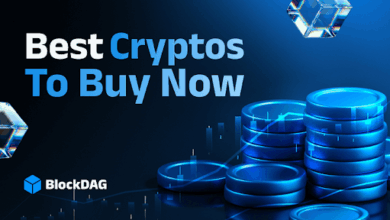News
Stay up to date on the latest crypto trends with our expert, in-depth coverage.
1Bitget Daily Digest(October 24)|Ethereum achieves real-time L1 block proof; Solmate surges 40% after $300M financing; Stable’s $825M pre-deposit raises insider concerns2Bitcoin falls below $115,000—is this a delayed reaction to the sale of 80,000 BTC?3Research Report|In-Depth Analysis and Market Cap of aPriori (APR)

SUI Targets Wave 3 Rally as $1.71 Level Defines Bullish Breakout Path
Cryptonewsland·2025/10/26 03:45

VELO Holds $0.0084 as Price Consolidates Above Fib 0.236, Mirroring 1,500% Historical Rally Setups
Cryptonewsland·2025/10/26 03:45

Fetch.ai Holds $0.26 Support as Chart Confirms Long-Term Bullish Channel Setup
Cryptonewsland·2025/10/26 03:45

4 Best Choices to Buy in October 2025: BlockDAG, Cosmos, Chainlink & Polkadot for Investing in Crypto
Discover why BlockDAG’s $430M+ presale leads October’s crypto picks, with Cosmos, Chainlink, and Polkadot ranking among 2025’s best coins for investing.2. Cosmos: Building Links Across Blockchains3. Chainlink: Expanding the Oracle Standard4. Polkadot: Reinventing with Modular GrowthWhich Is the Best For Investing in Crypto?
Coinomedia·2025/10/26 03:45
The Big Whale Has Gone All In: Accelerating Heavy Buying in This Altcoin
CryptoNewsNet·2025/10/26 03:24
Whale Deposit Triggers GIGGLE Token Price Surge
Coinlineup·2025/10/26 02:06
Pi Network Achieves Milestone in KYC Verification
Coinlive·2025/10/26 02:03
Solana Poised for Institutional Crypto Revolution in 2025
Coinlive·2025/10/26 02:03
JustLend DAO Completes First JST Buyback and Burn
Coinlive·2025/10/26 02:03
JPMorgan to Accept BTC and ETH as Loan Collateral
Coinlive·2025/10/26 02:03
Flash
- 04:11Data: The current Crypto Fear & Greed Index is 39, indicating a state of fear.ChainCatcher news, according to Coinglass data, the current cryptocurrency Fear & Greed Index is 39, up 1 point from yesterday. The 7-day average is 31, and the 30-day average is 43.
- 04:05Peter Schiff: If tokenized gold is a scam because it requires trusting a third party, then stablecoins backed by dollars held by a third party are also a scamJinse Finance reported that cryptocurrency critic Peter Schiff tweeted that if tokenized gold requires trusting a third party, then it is a scam, and the same applies to stablecoins that require trusting a third party to hold US dollars. "Surprisingly, many Bitcoin users who support and frequently use stablecoins claim that tokenized gold is a scam. Their issue is that they must trust a third party to hold their gold. But how is this any different from tokenized US dollars? Tokenized US dollars also require trusting a third party to hold their dollars."
- 03:59Roam launches dynamic difficulty adjustment mode, entering a scientifically adaptive phase for token issuance in the marketChainCatcher News, Roam officially announced the first launch of its token output difficulty adjustment mechanism, which will take effect starting from the 20,000th burn cycle. Thereafter, the system will automatically recalculate the difficulty every 1,000 cycles (approximately 11.6 days). According to the project's whitepaper, Roam draws inspiration from bitcoin's difficulty adjustment logic, binding token output to network verification activities (Check-In), and sets a "hash rate" benchmark for dynamic adjustment in units of every 1,000 cycles. This mechanism aims to synchronize the output pace with network activity: When verification activities remain stable, tokens are released according to the original schedule; If market fluctuations lead to a decrease in the number of verifications, the system will automatically reduce token output to alleviate selling pressure and stabilize the token price; Once network activity recovers or even exceeds previous highs, the token release rate will be correspondingly increased, and any previously delayed output due to difficulty adjustment will be compensated. As one of the core mechanisms of Roam's price protection system, the difficulty adjustment is designed to cope with volatile market cycles, maintain the long-term stability of the incentive structure, build a dynamically balanced and resilient token economic model, and safeguard the fundamental interests of network builders.